Financial Analysis and Management Accounting Report - Module XYZ
VerifiedAdded on 2020/10/05
|8
|2680
|129
Report
AI Summary
This report provides a financial analysis of Combo Applications, focusing on the application of IAS 16, IAS 28, IAS 36, and IAS 39. It examines the accounting treatment of specific transactions, including the purchase of a building and investments in shares. The report explores the implications of choosing between fair value and historical value accounting methods on the statement of profit and loss and the financial statements. A critical analysis of both fair value and historical value accounting methods is presented, discussing their advantages, disadvantages, and impact on financial reporting. The analysis considers the concepts of impairment of assets, investment in associates, and the impact of these choices on the financial position of the company. The report concludes with a summary of the findings and recommendations for future financial management strategies.
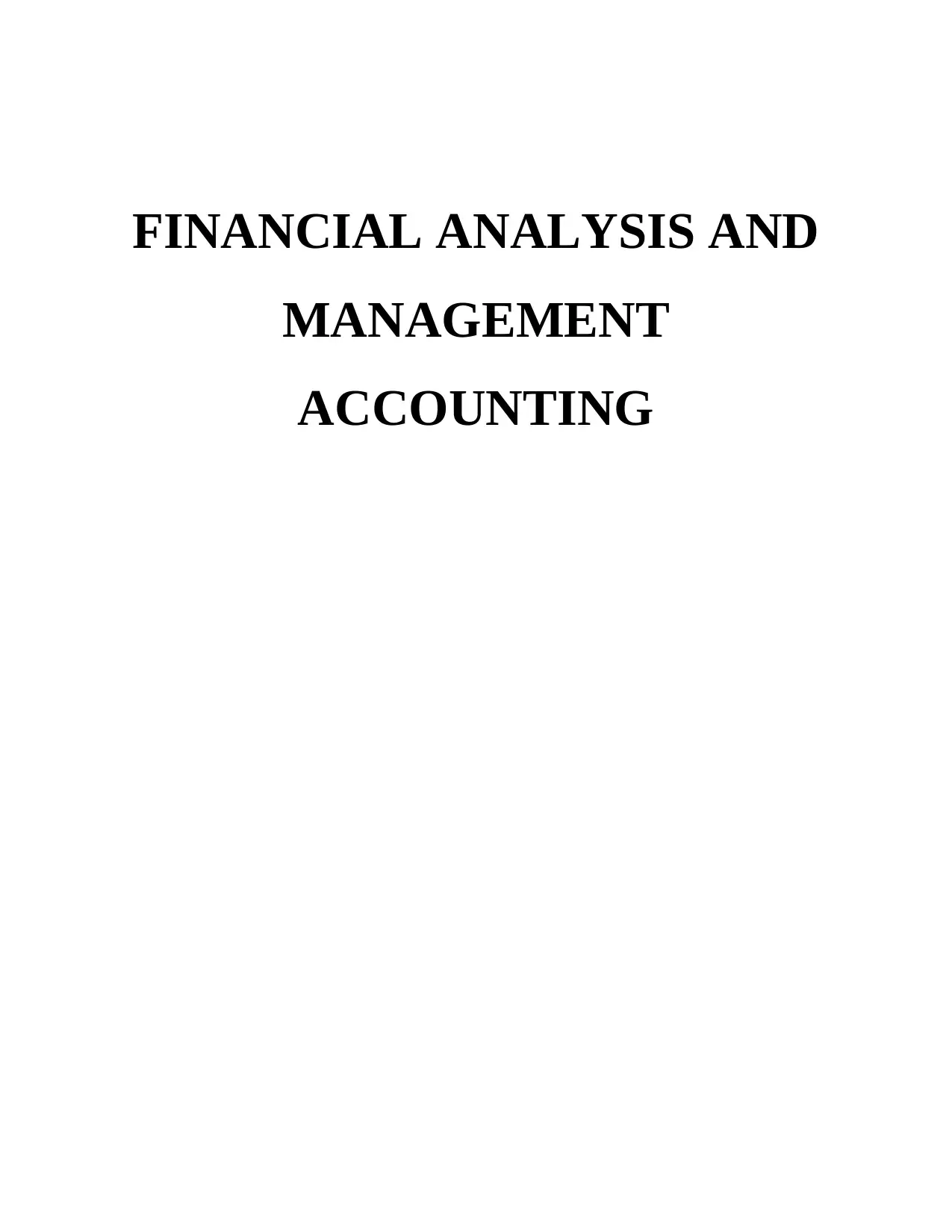
FINANCIAL ANALYSIS AND
MANAGEMENT
ACCOUNTING
MANAGEMENT
ACCOUNTING
Paraphrase This Document
Need a fresh take? Get an instant paraphrase of this document with our AI Paraphraser
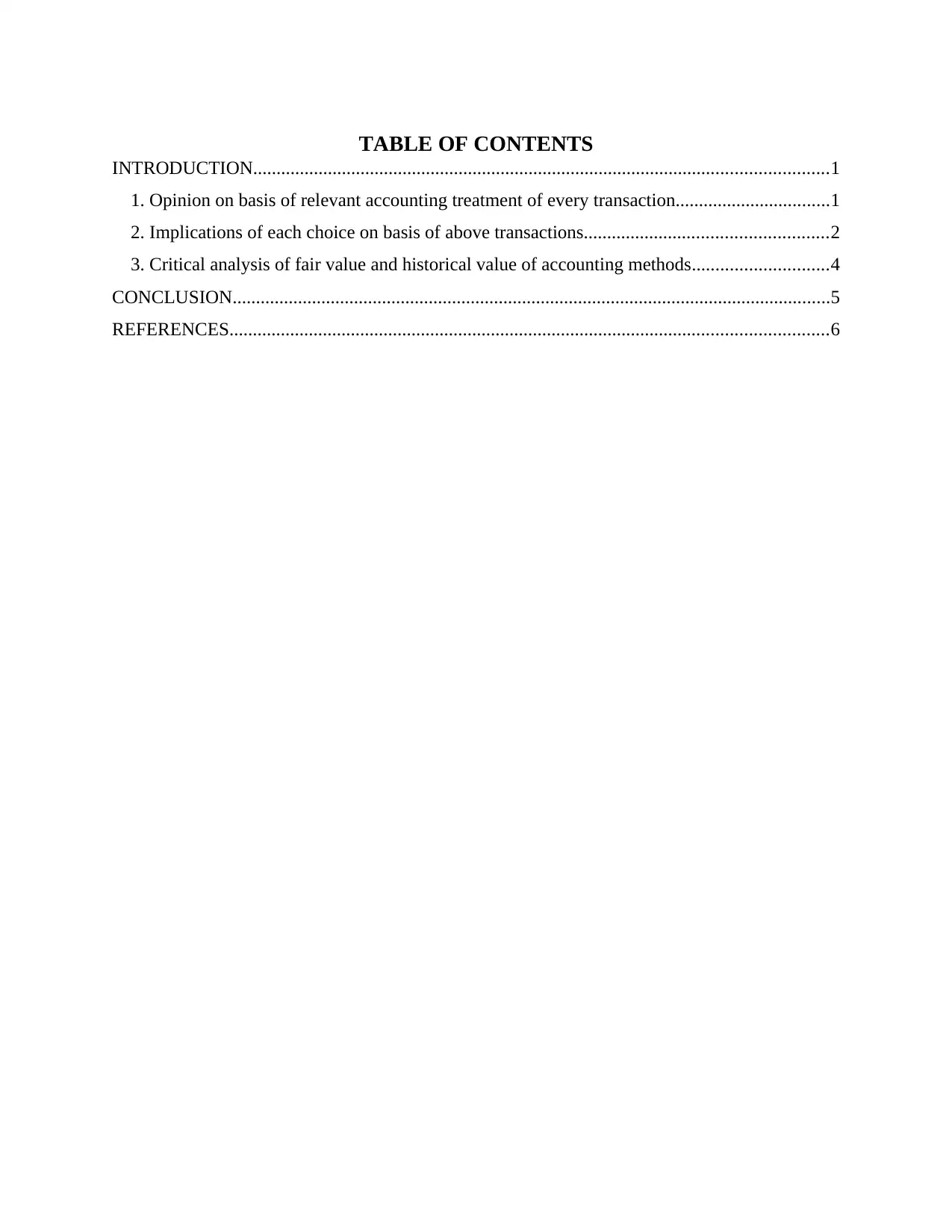
TABLE OF CONTENTS
INTRODUCTION...........................................................................................................................1
1. Opinion on basis of relevant accounting treatment of every transaction.................................1
2. Implications of each choice on basis of above transactions....................................................2
3. Critical analysis of fair value and historical value of accounting methods.............................4
CONCLUSION................................................................................................................................5
REFERENCES................................................................................................................................6
INTRODUCTION...........................................................................................................................1
1. Opinion on basis of relevant accounting treatment of every transaction.................................1
2. Implications of each choice on basis of above transactions....................................................2
3. Critical analysis of fair value and historical value of accounting methods.............................4
CONCLUSION................................................................................................................................5
REFERENCES................................................................................................................................6
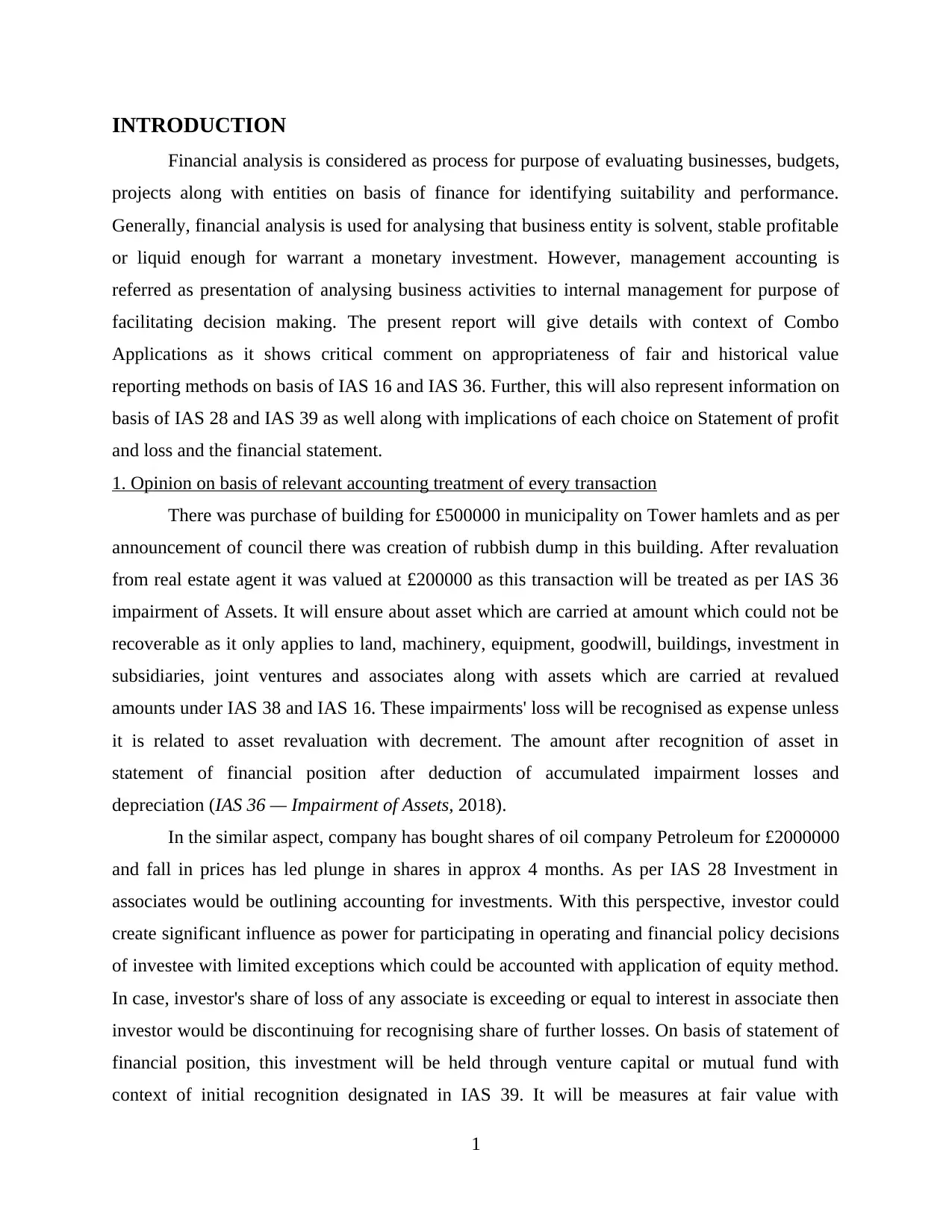
INTRODUCTION
Financial analysis is considered as process for purpose of evaluating businesses, budgets,
projects along with entities on basis of finance for identifying suitability and performance.
Generally, financial analysis is used for analysing that business entity is solvent, stable profitable
or liquid enough for warrant a monetary investment. However, management accounting is
referred as presentation of analysing business activities to internal management for purpose of
facilitating decision making. The present report will give details with context of Combo
Applications as it shows critical comment on appropriateness of fair and historical value
reporting methods on basis of IAS 16 and IAS 36. Further, this will also represent information on
basis of IAS 28 and IAS 39 as well along with implications of each choice on Statement of profit
and loss and the financial statement.
1. Opinion on basis of relevant accounting treatment of every transaction
There was purchase of building for £500000 in municipality on Tower hamlets and as per
announcement of council there was creation of rubbish dump in this building. After revaluation
from real estate agent it was valued at £200000 as this transaction will be treated as per IAS 36
impairment of Assets. It will ensure about asset which are carried at amount which could not be
recoverable as it only applies to land, machinery, equipment, goodwill, buildings, investment in
subsidiaries, joint ventures and associates along with assets which are carried at revalued
amounts under IAS 38 and IAS 16. These impairments' loss will be recognised as expense unless
it is related to asset revaluation with decrement. The amount after recognition of asset in
statement of financial position after deduction of accumulated impairment losses and
depreciation (IAS 36 — Impairment of Assets, 2018).
In the similar aspect, company has bought shares of oil company Petroleum for £2000000
and fall in prices has led plunge in shares in approx 4 months. As per IAS 28 Investment in
associates would be outlining accounting for investments. With this perspective, investor could
create significant influence as power for participating in operating and financial policy decisions
of investee with limited exceptions which could be accounted with application of equity method.
In case, investor's share of loss of any associate is exceeding or equal to interest in associate then
investor would be discontinuing for recognising share of further losses. On basis of statement of
financial position, this investment will be held through venture capital or mutual fund with
context of initial recognition designated in IAS 39. It will be measures at fair value with
1
Financial analysis is considered as process for purpose of evaluating businesses, budgets,
projects along with entities on basis of finance for identifying suitability and performance.
Generally, financial analysis is used for analysing that business entity is solvent, stable profitable
or liquid enough for warrant a monetary investment. However, management accounting is
referred as presentation of analysing business activities to internal management for purpose of
facilitating decision making. The present report will give details with context of Combo
Applications as it shows critical comment on appropriateness of fair and historical value
reporting methods on basis of IAS 16 and IAS 36. Further, this will also represent information on
basis of IAS 28 and IAS 39 as well along with implications of each choice on Statement of profit
and loss and the financial statement.
1. Opinion on basis of relevant accounting treatment of every transaction
There was purchase of building for £500000 in municipality on Tower hamlets and as per
announcement of council there was creation of rubbish dump in this building. After revaluation
from real estate agent it was valued at £200000 as this transaction will be treated as per IAS 36
impairment of Assets. It will ensure about asset which are carried at amount which could not be
recoverable as it only applies to land, machinery, equipment, goodwill, buildings, investment in
subsidiaries, joint ventures and associates along with assets which are carried at revalued
amounts under IAS 38 and IAS 16. These impairments' loss will be recognised as expense unless
it is related to asset revaluation with decrement. The amount after recognition of asset in
statement of financial position after deduction of accumulated impairment losses and
depreciation (IAS 36 — Impairment of Assets, 2018).
In the similar aspect, company has bought shares of oil company Petroleum for £2000000
and fall in prices has led plunge in shares in approx 4 months. As per IAS 28 Investment in
associates would be outlining accounting for investments. With this perspective, investor could
create significant influence as power for participating in operating and financial policy decisions
of investee with limited exceptions which could be accounted with application of equity method.
In case, investor's share of loss of any associate is exceeding or equal to interest in associate then
investor would be discontinuing for recognising share of further losses. On basis of statement of
financial position, this investment will be held through venture capital or mutual fund with
context of initial recognition designated in IAS 39. It will be measures at fair value with
1
⊘ This is a preview!⊘
Do you want full access?
Subscribe today to unlock all pages.

Trusted by 1+ million students worldwide
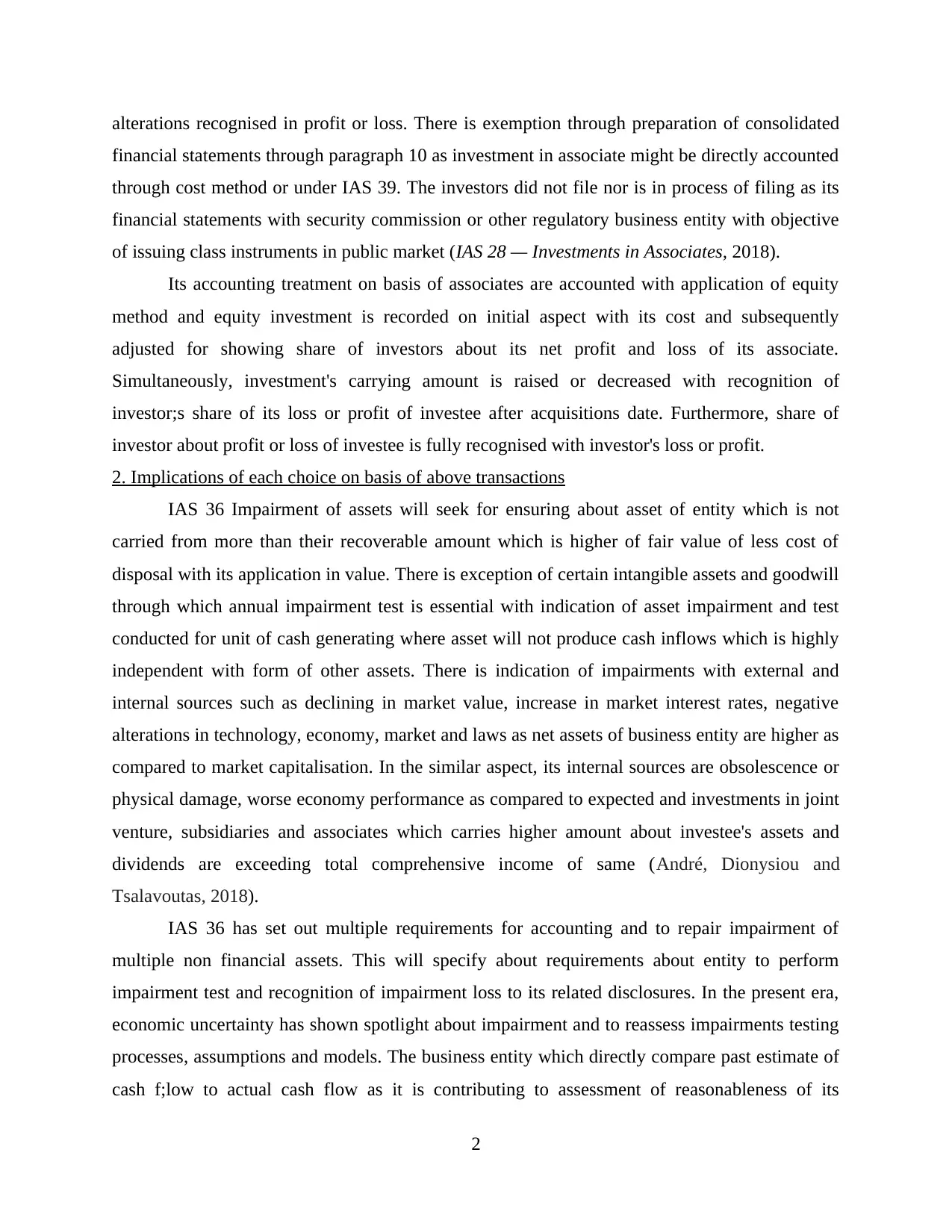
alterations recognised in profit or loss. There is exemption through preparation of consolidated
financial statements through paragraph 10 as investment in associate might be directly accounted
through cost method or under IAS 39. The investors did not file nor is in process of filing as its
financial statements with security commission or other regulatory business entity with objective
of issuing class instruments in public market (IAS 28 — Investments in Associates, 2018).
Its accounting treatment on basis of associates are accounted with application of equity
method and equity investment is recorded on initial aspect with its cost and subsequently
adjusted for showing share of investors about its net profit and loss of its associate.
Simultaneously, investment's carrying amount is raised or decreased with recognition of
investor;s share of its loss or profit of investee after acquisitions date. Furthermore, share of
investor about profit or loss of investee is fully recognised with investor's loss or profit.
2. Implications of each choice on basis of above transactions
IAS 36 Impairment of assets will seek for ensuring about asset of entity which is not
carried from more than their recoverable amount which is higher of fair value of less cost of
disposal with its application in value. There is exception of certain intangible assets and goodwill
through which annual impairment test is essential with indication of asset impairment and test
conducted for unit of cash generating where asset will not produce cash inflows which is highly
independent with form of other assets. There is indication of impairments with external and
internal sources such as declining in market value, increase in market interest rates, negative
alterations in technology, economy, market and laws as net assets of business entity are higher as
compared to market capitalisation. In the similar aspect, its internal sources are obsolescence or
physical damage, worse economy performance as compared to expected and investments in joint
venture, subsidiaries and associates which carries higher amount about investee's assets and
dividends are exceeding total comprehensive income of same (André, Dionysiou and
Tsalavoutas, 2018).
IAS 36 has set out multiple requirements for accounting and to repair impairment of
multiple non financial assets. This will specify about requirements about entity to perform
impairment test and recognition of impairment loss to its related disclosures. In the present era,
economic uncertainty has shown spotlight about impairment and to reassess impairments testing
processes, assumptions and models. The business entity which directly compare past estimate of
cash f;low to actual cash flow as it is contributing to assessment of reasonableness of its
2
financial statements through paragraph 10 as investment in associate might be directly accounted
through cost method or under IAS 39. The investors did not file nor is in process of filing as its
financial statements with security commission or other regulatory business entity with objective
of issuing class instruments in public market (IAS 28 — Investments in Associates, 2018).
Its accounting treatment on basis of associates are accounted with application of equity
method and equity investment is recorded on initial aspect with its cost and subsequently
adjusted for showing share of investors about its net profit and loss of its associate.
Simultaneously, investment's carrying amount is raised or decreased with recognition of
investor;s share of its loss or profit of investee after acquisitions date. Furthermore, share of
investor about profit or loss of investee is fully recognised with investor's loss or profit.
2. Implications of each choice on basis of above transactions
IAS 36 Impairment of assets will seek for ensuring about asset of entity which is not
carried from more than their recoverable amount which is higher of fair value of less cost of
disposal with its application in value. There is exception of certain intangible assets and goodwill
through which annual impairment test is essential with indication of asset impairment and test
conducted for unit of cash generating where asset will not produce cash inflows which is highly
independent with form of other assets. There is indication of impairments with external and
internal sources such as declining in market value, increase in market interest rates, negative
alterations in technology, economy, market and laws as net assets of business entity are higher as
compared to market capitalisation. In the similar aspect, its internal sources are obsolescence or
physical damage, worse economy performance as compared to expected and investments in joint
venture, subsidiaries and associates which carries higher amount about investee's assets and
dividends are exceeding total comprehensive income of same (André, Dionysiou and
Tsalavoutas, 2018).
IAS 36 has set out multiple requirements for accounting and to repair impairment of
multiple non financial assets. This will specify about requirements about entity to perform
impairment test and recognition of impairment loss to its related disclosures. In the present era,
economic uncertainty has shown spotlight about impairment and to reassess impairments testing
processes, assumptions and models. The business entity which directly compare past estimate of
cash f;low to actual cash flow as it is contributing to assessment of reasonableness of its
2
Paraphrase This Document
Need a fresh take? Get an instant paraphrase of this document with our AI Paraphraser
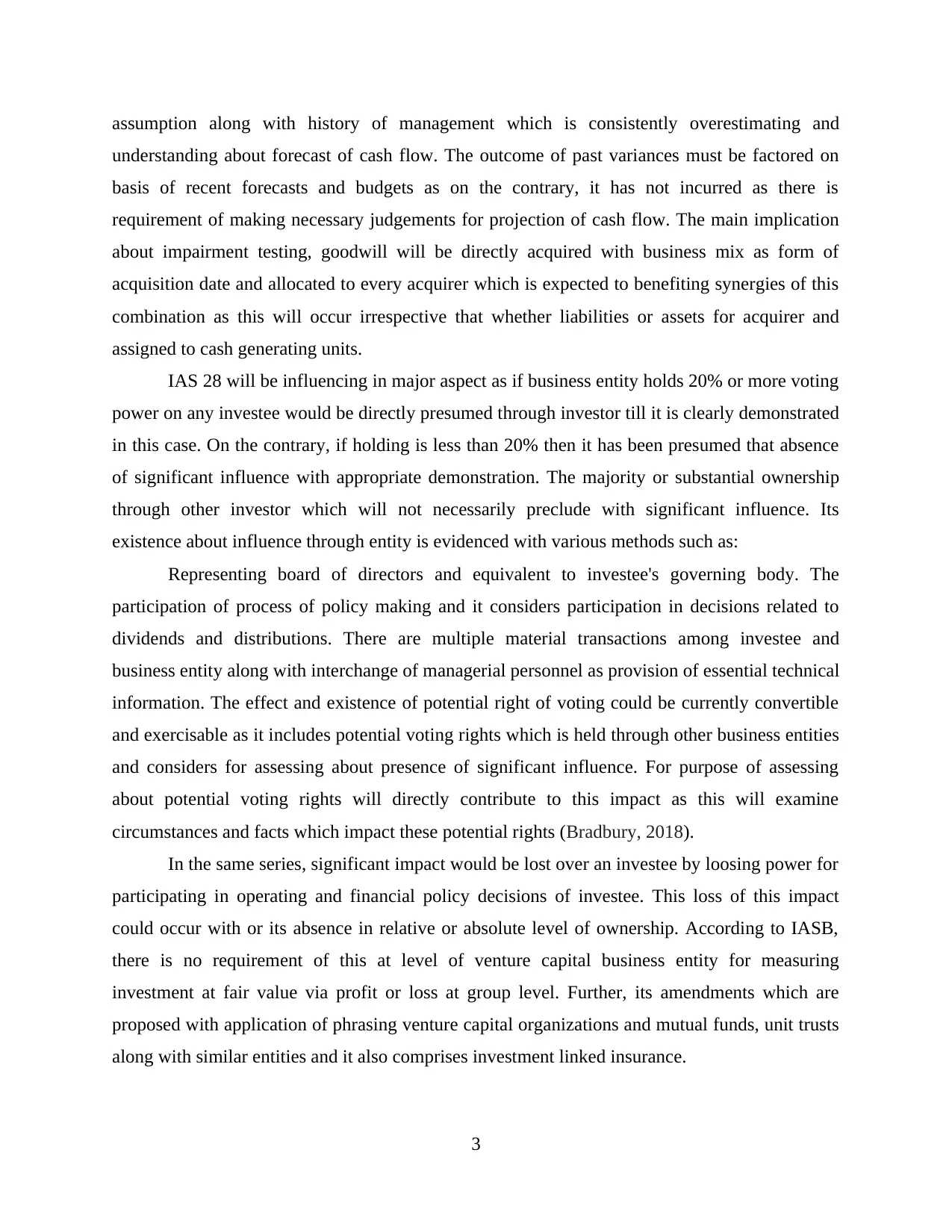
assumption along with history of management which is consistently overestimating and
understanding about forecast of cash flow. The outcome of past variances must be factored on
basis of recent forecasts and budgets as on the contrary, it has not incurred as there is
requirement of making necessary judgements for projection of cash flow. The main implication
about impairment testing, goodwill will be directly acquired with business mix as form of
acquisition date and allocated to every acquirer which is expected to benefiting synergies of this
combination as this will occur irrespective that whether liabilities or assets for acquirer and
assigned to cash generating units.
IAS 28 will be influencing in major aspect as if business entity holds 20% or more voting
power on any investee would be directly presumed through investor till it is clearly demonstrated
in this case. On the contrary, if holding is less than 20% then it has been presumed that absence
of significant influence with appropriate demonstration. The majority or substantial ownership
through other investor which will not necessarily preclude with significant influence. Its
existence about influence through entity is evidenced with various methods such as:
Representing board of directors and equivalent to investee's governing body. The
participation of process of policy making and it considers participation in decisions related to
dividends and distributions. There are multiple material transactions among investee and
business entity along with interchange of managerial personnel as provision of essential technical
information. The effect and existence of potential right of voting could be currently convertible
and exercisable as it includes potential voting rights which is held through other business entities
and considers for assessing about presence of significant influence. For purpose of assessing
about potential voting rights will directly contribute to this impact as this will examine
circumstances and facts which impact these potential rights (Bradbury, 2018).
In the same series, significant impact would be lost over an investee by loosing power for
participating in operating and financial policy decisions of investee. This loss of this impact
could occur with or its absence in relative or absolute level of ownership. According to IASB,
there is no requirement of this at level of venture capital business entity for measuring
investment at fair value via profit or loss at group level. Further, its amendments which are
proposed with application of phrasing venture capital organizations and mutual funds, unit trusts
along with similar entities and it also comprises investment linked insurance.
3
understanding about forecast of cash flow. The outcome of past variances must be factored on
basis of recent forecasts and budgets as on the contrary, it has not incurred as there is
requirement of making necessary judgements for projection of cash flow. The main implication
about impairment testing, goodwill will be directly acquired with business mix as form of
acquisition date and allocated to every acquirer which is expected to benefiting synergies of this
combination as this will occur irrespective that whether liabilities or assets for acquirer and
assigned to cash generating units.
IAS 28 will be influencing in major aspect as if business entity holds 20% or more voting
power on any investee would be directly presumed through investor till it is clearly demonstrated
in this case. On the contrary, if holding is less than 20% then it has been presumed that absence
of significant influence with appropriate demonstration. The majority or substantial ownership
through other investor which will not necessarily preclude with significant influence. Its
existence about influence through entity is evidenced with various methods such as:
Representing board of directors and equivalent to investee's governing body. The
participation of process of policy making and it considers participation in decisions related to
dividends and distributions. There are multiple material transactions among investee and
business entity along with interchange of managerial personnel as provision of essential technical
information. The effect and existence of potential right of voting could be currently convertible
and exercisable as it includes potential voting rights which is held through other business entities
and considers for assessing about presence of significant influence. For purpose of assessing
about potential voting rights will directly contribute to this impact as this will examine
circumstances and facts which impact these potential rights (Bradbury, 2018).
In the same series, significant impact would be lost over an investee by loosing power for
participating in operating and financial policy decisions of investee. This loss of this impact
could occur with or its absence in relative or absolute level of ownership. According to IASB,
there is no requirement of this at level of venture capital business entity for measuring
investment at fair value via profit or loss at group level. Further, its amendments which are
proposed with application of phrasing venture capital organizations and mutual funds, unit trusts
along with similar entities and it also comprises investment linked insurance.
3
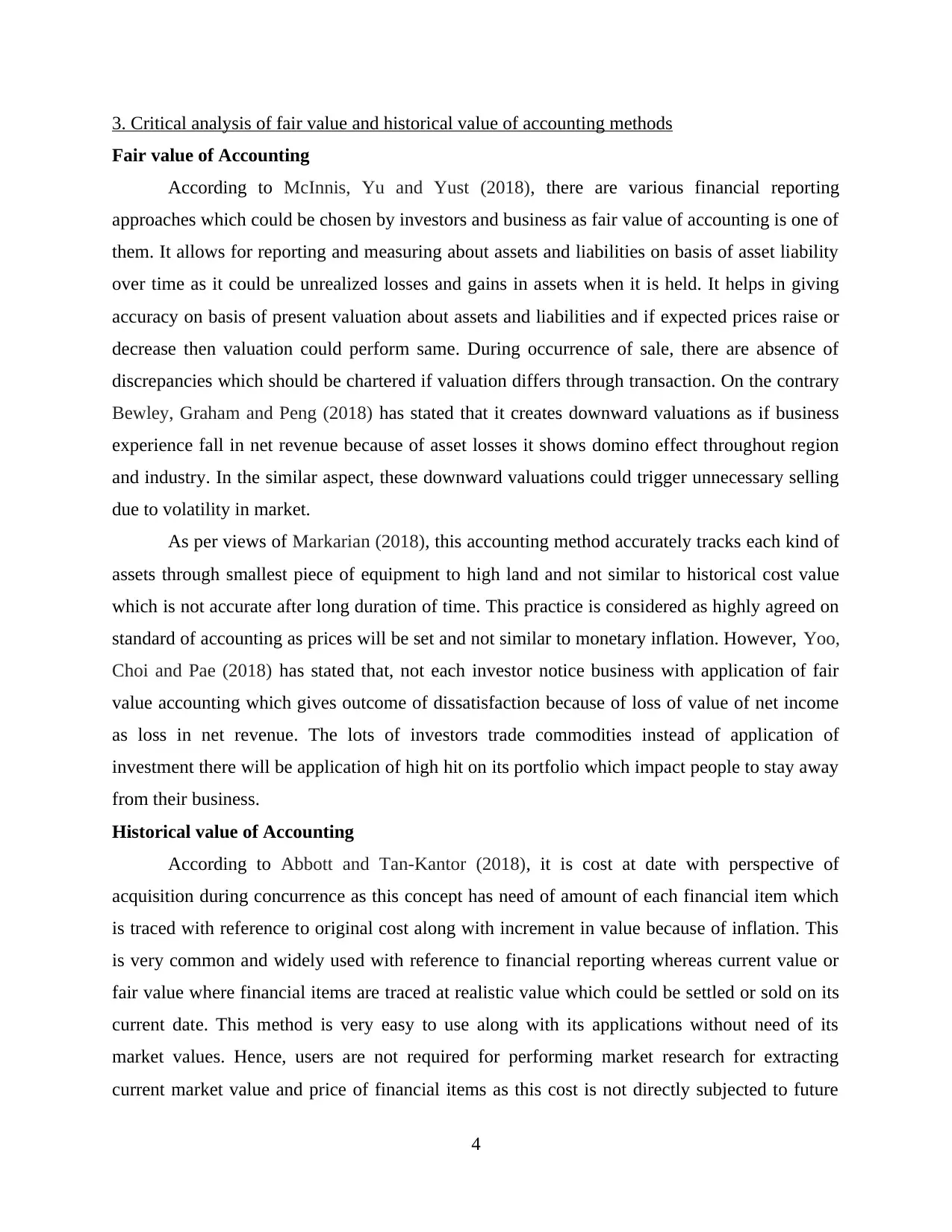
3. Critical analysis of fair value and historical value of accounting methods
Fair value of Accounting
According to McInnis, Yu and Yust (2018), there are various financial reporting
approaches which could be chosen by investors and business as fair value of accounting is one of
them. It allows for reporting and measuring about assets and liabilities on basis of asset liability
over time as it could be unrealized losses and gains in assets when it is held. It helps in giving
accuracy on basis of present valuation about assets and liabilities and if expected prices raise or
decrease then valuation could perform same. During occurrence of sale, there are absence of
discrepancies which should be chartered if valuation differs through transaction. On the contrary
Bewley, Graham and Peng (2018) has stated that it creates downward valuations as if business
experience fall in net revenue because of asset losses it shows domino effect throughout region
and industry. In the similar aspect, these downward valuations could trigger unnecessary selling
due to volatility in market.
As per views of Markarian (2018), this accounting method accurately tracks each kind of
assets through smallest piece of equipment to high land and not similar to historical cost value
which is not accurate after long duration of time. This practice is considered as highly agreed on
standard of accounting as prices will be set and not similar to monetary inflation. However, Yoo,
Choi and Pae (2018) has stated that, not each investor notice business with application of fair
value accounting which gives outcome of dissatisfaction because of loss of value of net income
as loss in net revenue. The lots of investors trade commodities instead of application of
investment there will be application of high hit on its portfolio which impact people to stay away
from their business.
Historical value of Accounting
According to Abbott and Tan‐Kantor (2018), it is cost at date with perspective of
acquisition during concurrence as this concept has need of amount of each financial item which
is traced with reference to original cost along with increment in value because of inflation. This
is very common and widely used with reference to financial reporting whereas current value or
fair value where financial items are traced at realistic value which could be settled or sold on its
current date. This method is very easy to use along with its applications without need of its
market values. Hence, users are not required for performing market research for extracting
current market value and price of financial items as this cost is not directly subjected to future
4
Fair value of Accounting
According to McInnis, Yu and Yust (2018), there are various financial reporting
approaches which could be chosen by investors and business as fair value of accounting is one of
them. It allows for reporting and measuring about assets and liabilities on basis of asset liability
over time as it could be unrealized losses and gains in assets when it is held. It helps in giving
accuracy on basis of present valuation about assets and liabilities and if expected prices raise or
decrease then valuation could perform same. During occurrence of sale, there are absence of
discrepancies which should be chartered if valuation differs through transaction. On the contrary
Bewley, Graham and Peng (2018) has stated that it creates downward valuations as if business
experience fall in net revenue because of asset losses it shows domino effect throughout region
and industry. In the similar aspect, these downward valuations could trigger unnecessary selling
due to volatility in market.
As per views of Markarian (2018), this accounting method accurately tracks each kind of
assets through smallest piece of equipment to high land and not similar to historical cost value
which is not accurate after long duration of time. This practice is considered as highly agreed on
standard of accounting as prices will be set and not similar to monetary inflation. However, Yoo,
Choi and Pae (2018) has stated that, not each investor notice business with application of fair
value accounting which gives outcome of dissatisfaction because of loss of value of net income
as loss in net revenue. The lots of investors trade commodities instead of application of
investment there will be application of high hit on its portfolio which impact people to stay away
from their business.
Historical value of Accounting
According to Abbott and Tan‐Kantor (2018), it is cost at date with perspective of
acquisition during concurrence as this concept has need of amount of each financial item which
is traced with reference to original cost along with increment in value because of inflation. This
is very common and widely used with reference to financial reporting whereas current value or
fair value where financial items are traced at realistic value which could be settled or sold on its
current date. This method is very easy to use along with its applications without need of its
market values. Hence, users are not required for performing market research for extracting
current market value and price of financial items as this cost is not directly subjected to future
4
⊘ This is a preview!⊘
Do you want full access?
Subscribe today to unlock all pages.

Trusted by 1+ million students worldwide
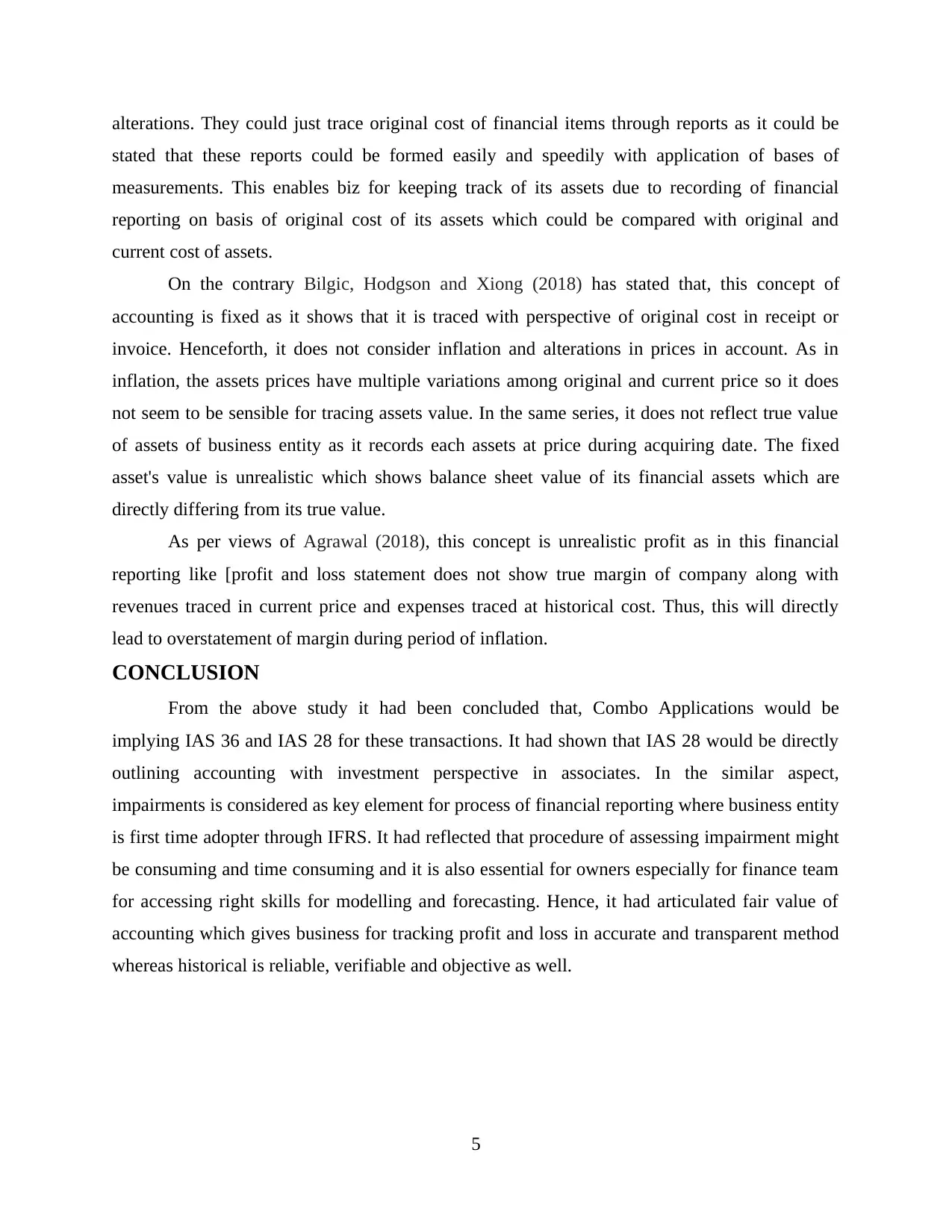
alterations. They could just trace original cost of financial items through reports as it could be
stated that these reports could be formed easily and speedily with application of bases of
measurements. This enables biz for keeping track of its assets due to recording of financial
reporting on basis of original cost of its assets which could be compared with original and
current cost of assets.
On the contrary Bilgic, Hodgson and Xiong (2018) has stated that, this concept of
accounting is fixed as it shows that it is traced with perspective of original cost in receipt or
invoice. Henceforth, it does not consider inflation and alterations in prices in account. As in
inflation, the assets prices have multiple variations among original and current price so it does
not seem to be sensible for tracing assets value. In the same series, it does not reflect true value
of assets of business entity as it records each assets at price during acquiring date. The fixed
asset's value is unrealistic which shows balance sheet value of its financial assets which are
directly differing from its true value.
As per views of Agrawal (2018), this concept is unrealistic profit as in this financial
reporting like [profit and loss statement does not show true margin of company along with
revenues traced in current price and expenses traced at historical cost. Thus, this will directly
lead to overstatement of margin during period of inflation.
CONCLUSION
From the above study it had been concluded that, Combo Applications would be
implying IAS 36 and IAS 28 for these transactions. It had shown that IAS 28 would be directly
outlining accounting with investment perspective in associates. In the similar aspect,
impairments is considered as key element for process of financial reporting where business entity
is first time adopter through IFRS. It had reflected that procedure of assessing impairment might
be consuming and time consuming and it is also essential for owners especially for finance team
for accessing right skills for modelling and forecasting. Hence, it had articulated fair value of
accounting which gives business for tracking profit and loss in accurate and transparent method
whereas historical is reliable, verifiable and objective as well.
5
stated that these reports could be formed easily and speedily with application of bases of
measurements. This enables biz for keeping track of its assets due to recording of financial
reporting on basis of original cost of its assets which could be compared with original and
current cost of assets.
On the contrary Bilgic, Hodgson and Xiong (2018) has stated that, this concept of
accounting is fixed as it shows that it is traced with perspective of original cost in receipt or
invoice. Henceforth, it does not consider inflation and alterations in prices in account. As in
inflation, the assets prices have multiple variations among original and current price so it does
not seem to be sensible for tracing assets value. In the same series, it does not reflect true value
of assets of business entity as it records each assets at price during acquiring date. The fixed
asset's value is unrealistic which shows balance sheet value of its financial assets which are
directly differing from its true value.
As per views of Agrawal (2018), this concept is unrealistic profit as in this financial
reporting like [profit and loss statement does not show true margin of company along with
revenues traced in current price and expenses traced at historical cost. Thus, this will directly
lead to overstatement of margin during period of inflation.
CONCLUSION
From the above study it had been concluded that, Combo Applications would be
implying IAS 36 and IAS 28 for these transactions. It had shown that IAS 28 would be directly
outlining accounting with investment perspective in associates. In the similar aspect,
impairments is considered as key element for process of financial reporting where business entity
is first time adopter through IFRS. It had reflected that procedure of assessing impairment might
be consuming and time consuming and it is also essential for owners especially for finance team
for accessing right skills for modelling and forecasting. Hence, it had articulated fair value of
accounting which gives business for tracking profit and loss in accurate and transparent method
whereas historical is reliable, verifiable and objective as well.
5
Paraphrase This Document
Need a fresh take? Get an instant paraphrase of this document with our AI Paraphraser
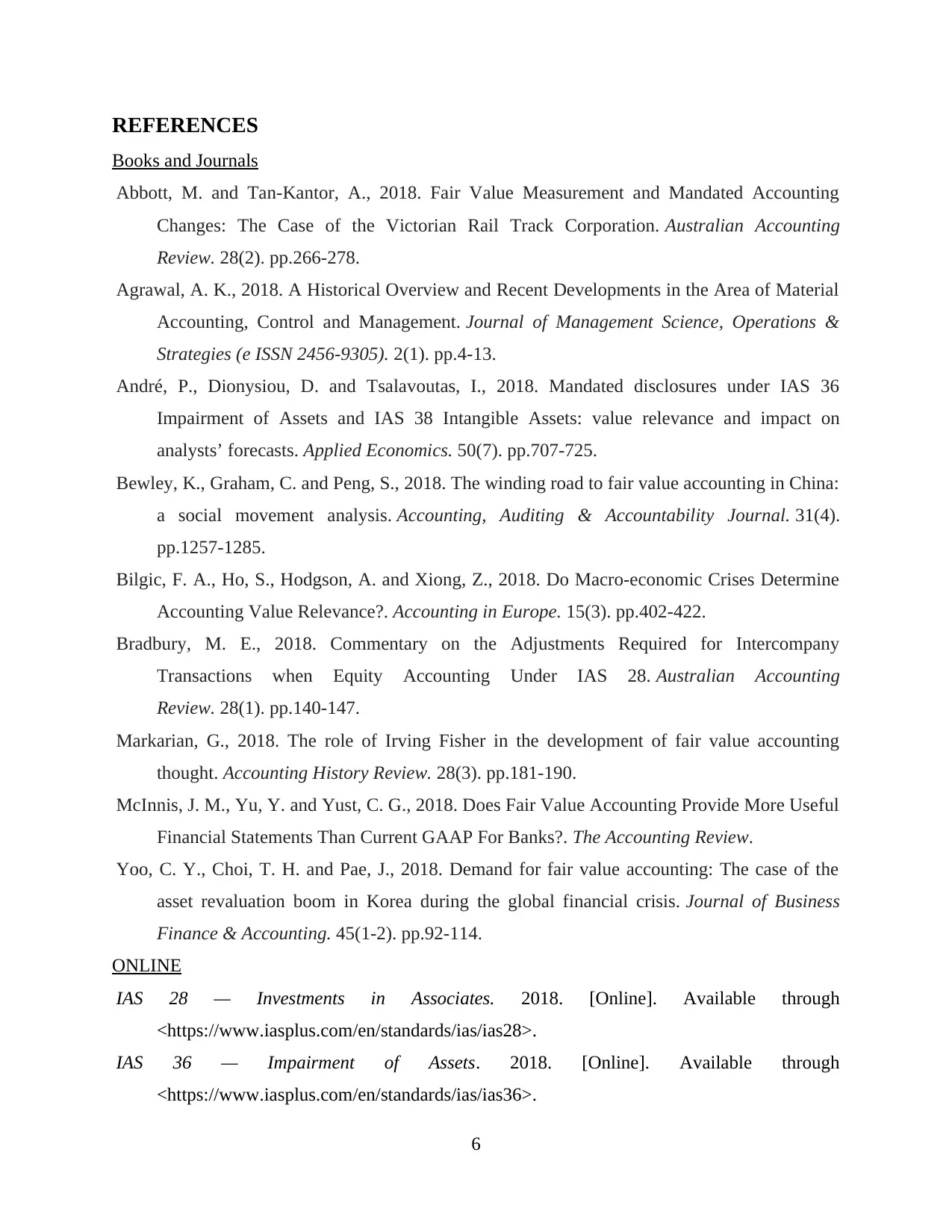
REFERENCES
Books and Journals
Abbott, M. and Tan‐Kantor, A., 2018. Fair Value Measurement and Mandated Accounting
Changes: The Case of the Victorian Rail Track Corporation. Australian Accounting
Review. 28(2). pp.266-278.
Agrawal, A. K., 2018. A Historical Overview and Recent Developments in the Area of Material
Accounting, Control and Management. Journal of Management Science, Operations &
Strategies (e ISSN 2456-9305). 2(1). pp.4-13.
André, P., Dionysiou, D. and Tsalavoutas, I., 2018. Mandated disclosures under IAS 36
Impairment of Assets and IAS 38 Intangible Assets: value relevance and impact on
analysts’ forecasts. Applied Economics. 50(7). pp.707-725.
Bewley, K., Graham, C. and Peng, S., 2018. The winding road to fair value accounting in China:
a social movement analysis. Accounting, Auditing & Accountability Journal. 31(4).
pp.1257-1285.
Bilgic, F. A., Ho, S., Hodgson, A. and Xiong, Z., 2018. Do Macro-economic Crises Determine
Accounting Value Relevance?. Accounting in Europe. 15(3). pp.402-422.
Bradbury, M. E., 2018. Commentary on the Adjustments Required for Intercompany
Transactions when Equity Accounting Under IAS 28. Australian Accounting
Review. 28(1). pp.140-147.
Markarian, G., 2018. The role of Irving Fisher in the development of fair value accounting
thought. Accounting History Review. 28(3). pp.181-190.
McInnis, J. M., Yu, Y. and Yust, C. G., 2018. Does Fair Value Accounting Provide More Useful
Financial Statements Than Current GAAP For Banks?. The Accounting Review.
Yoo, C. Y., Choi, T. H. and Pae, J., 2018. Demand for fair value accounting: The case of the
asset revaluation boom in Korea during the global financial crisis. Journal of Business
Finance & Accounting. 45(1-2). pp.92-114.
ONLINE
IAS 28 — Investments in Associates. 2018. [Online]. Available through
<https://www.iasplus.com/en/standards/ias/ias28>.
IAS 36 — Impairment of Assets. 2018. [Online]. Available through
<https://www.iasplus.com/en/standards/ias/ias36>.
6
Books and Journals
Abbott, M. and Tan‐Kantor, A., 2018. Fair Value Measurement and Mandated Accounting
Changes: The Case of the Victorian Rail Track Corporation. Australian Accounting
Review. 28(2). pp.266-278.
Agrawal, A. K., 2018. A Historical Overview and Recent Developments in the Area of Material
Accounting, Control and Management. Journal of Management Science, Operations &
Strategies (e ISSN 2456-9305). 2(1). pp.4-13.
André, P., Dionysiou, D. and Tsalavoutas, I., 2018. Mandated disclosures under IAS 36
Impairment of Assets and IAS 38 Intangible Assets: value relevance and impact on
analysts’ forecasts. Applied Economics. 50(7). pp.707-725.
Bewley, K., Graham, C. and Peng, S., 2018. The winding road to fair value accounting in China:
a social movement analysis. Accounting, Auditing & Accountability Journal. 31(4).
pp.1257-1285.
Bilgic, F. A., Ho, S., Hodgson, A. and Xiong, Z., 2018. Do Macro-economic Crises Determine
Accounting Value Relevance?. Accounting in Europe. 15(3). pp.402-422.
Bradbury, M. E., 2018. Commentary on the Adjustments Required for Intercompany
Transactions when Equity Accounting Under IAS 28. Australian Accounting
Review. 28(1). pp.140-147.
Markarian, G., 2018. The role of Irving Fisher in the development of fair value accounting
thought. Accounting History Review. 28(3). pp.181-190.
McInnis, J. M., Yu, Y. and Yust, C. G., 2018. Does Fair Value Accounting Provide More Useful
Financial Statements Than Current GAAP For Banks?. The Accounting Review.
Yoo, C. Y., Choi, T. H. and Pae, J., 2018. Demand for fair value accounting: The case of the
asset revaluation boom in Korea during the global financial crisis. Journal of Business
Finance & Accounting. 45(1-2). pp.92-114.
ONLINE
IAS 28 — Investments in Associates. 2018. [Online]. Available through
<https://www.iasplus.com/en/standards/ias/ias28>.
IAS 36 — Impairment of Assets. 2018. [Online]. Available through
<https://www.iasplus.com/en/standards/ias/ias36>.
6
1 out of 8
Related Documents
Your All-in-One AI-Powered Toolkit for Academic Success.
+13062052269
info@desklib.com
Available 24*7 on WhatsApp / Email
![[object Object]](/_next/static/media/star-bottom.7253800d.svg)
Unlock your academic potential
Copyright © 2020–2025 A2Z Services. All Rights Reserved. Developed and managed by ZUCOL.





